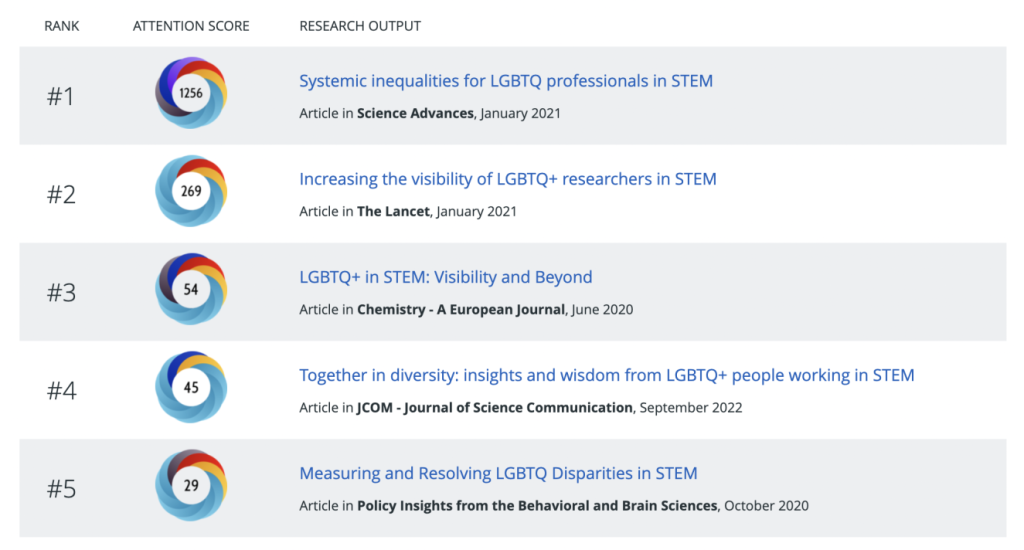LGBTQ+ in STEM: examining scholarly conversations

Using Altmetric Explorer, we highlight the academic papers making the biggest impact in the field of LGBTQ+ inclusivity in STEM in recent years.
While Pride Month draws to a close in many countries at the end of June – with some events continuing into July, such as in the UK – academic research into LGBTQ+ inclusivity continues all year round. One important facet of this research is looking into LGBTQ+ inclusivity in STEM (Science, Technology, Engineering, and Mathematics).
So why focus on STEM? The progress in STEM disciplines undeniably propels our society forward, acting as a catalyst for technological disruption and innovation. A prime example is recent advancements in Artificial Intelligence (AI), widely regarded as some of the most profound disruptors that will revolutionize our global functioning. It is crucial to acknowledge that bias, stemming from a lack of diversity and inclusion, represents a blind spot in AI. And so, understanding the scholarly conversations surrounding diversity and inclusivity – including those that involve the LGBTQ+ community – becomes essential as we navigate the future.
To better understand the wider impact of scholarly conversations on the topic, we used Altmetric Explorer to look at the Altmetric Attention Score of publications using the key phrases “LGBTQ+ and STEM” and “LGBT and STEM”. Here are the papers attracting the most attention worldwide.

With the combination “LGBTQ+ and STEM, the paper with the highest Altmetric Attention Score of 1256 is Systemic inequalities for LGBTQ professionals in STEM, authored by Erin Cech (University of Michigan, Ann Arbor) and Tom Waidzunas (Temple University: Philadelphia) and published in Science Advances in 2021. The study surveyed more than 25,000 U.S.-based STEM workers, of whom approximately 1000 identified as LGBTQ. It showed that LGBTQ professionals in STEM are 30% more likely to experience workplace harassment than non-LGBTQ peers.
Second on the list is an article titled Increasing the visibility of LGBTQ+ researchers in STEM, by Matthew Sinton (University of Glasgow) et al., published in The Lancet. The authors propose interventions to increase the visibility of LGBTQ+ researchers; they write that those who can come to terms with their sexual and gender orientation can serve as role models for the entire community.
The top five publications also include LGBTQ+ in STEM: Visibility and Beyond, Together in diversity: insights and wisdom from LGBTQ+ people working in STEM, and Measuring and Resolving LGBTQ Disparities in STEM.

With the key phrase combination “LGBT and STEM”, a news article published in Nature, How LGBT+ scientists would like to be included and welcomed in STEM workplaces, comes top with an Altmetric Attention Score of 723. The piece outlines the steps that peers and institutions can take to make laboratories, conferences and lecture halls safe and inclusive spaces.
Second on this list is Queer in STEM Organizations: Workplace Disadvantages for LGBT Employees in STEM Related Federal Agencies, an article that looks into persistent inequalities that employees from the LGBT community face despite the non-discrimination policies and accountability structures that exist in STEM-related federal agencies in the US.
All these articles provide valuable insights into the challenges faced by those from the LGBTQ+ community in STEM and underscore the significance of research in promoting visibility and inclusivity to address these issues.
Using Altmetric Attention Scores to assess scholarly publications on LGBTQ+ in STEM helps emphasize the conversations surrounding these works and their wider impact. The hope is that these metrics can be further used to recognize and amplify crucial discussions on the topic within and outside the academic community. This is essential for driving positive change and creating a more equitable future driven by non-biased technological and scientific advances.
